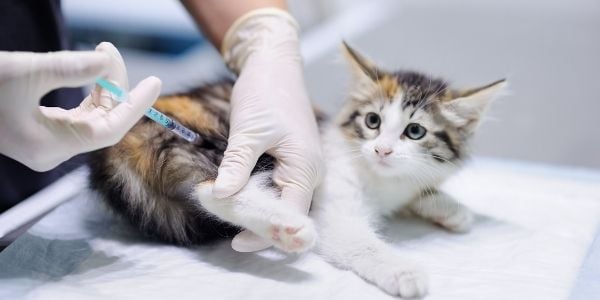 While I am in no way a history buff, I feel that knowing the past can aid the future, especially when it comes to the effectiveness of vaccines.
While I am in no way a history buff, I feel that knowing the past can aid the future, especially when it comes to the effectiveness of vaccines.
Additionally, I found it interesting and a bit (well, a lot) gross how the first inoculation took place.
Dr. Edward Jenner administered the first ‘vaccine’ in 1796. During that time, there was a smallpox epidemic, and millions of people were dying.
The physicist noticed that milkmaids developed pustules (pimples) but didn’t become sick with smallpox if they were exposed to cowpox prior.
So the brilliant man took the pus from a milk maid’s hand and injected it into a boy. This simple process allowed the boy to be resistant to future exposures of smallpox. This act of brilliance paved the way for vaccines.
It was a chemist named Louis Pasteur who developed the first vaccine in 1879 relating to animal diseases. His success with his rabies vaccine on animals in 1884 prompted its use in humans.
Vaccines, for both humans and pets, are developed for those diseases that tend to have high mortality and/or high incidence rates. Vaccinations have been saving lives for centuries.
Skip to:
Recommended Cat Vaccines
Optional Cat Vaccines
Vaccine Side Effects
Why Vaccines Are Important for Cats
How a Veterinarian Determines the Vaccine Protocol
Vaccine Schedule for Kittens & Adults
Titer Testing for Cats
What to Do If Your Cat Misses Vaccines
What Vaccines Do Cats Need?
Which vaccines your cat needs and the frequency will be determined by you and your veterinarian. It's based on your cat's age, lifestyle, risk factors, etc. Your vet will ask you several questions about your cat. For those questions, check out the section below.
What are the core cat vaccine diseases?
Core vaccines are those recommended for all cats based on the risk of exposure, the severity of the disease to be prevented, and the risk the disease poses to humans. These are the diseases these vaccines prevent.
Skip to:
Feline Viral Rhinotracheitis
Feline Calicivirus
Feline Panleukopenia (aka Feline Parvo or Distemper)
Feline Leukemia Virus (FeLV)
Rabies
Feline Viral Rhinotracheitis (also referred to as Herpes)
The herpesvirus, Feline Viral Rhinotracheitis, is an infectious disease that is the most common cause of conjunctivitis in cats.
It has been found to be the cause of 80% to 90% of feline infectious upper respiratory diseases or pulmonary infections in cats. The virus can affect cats of all ages and it is highly contagious.
Symptoms of the disease are usually noticed 2 to 5 days after the cat has been infected. The active infection will last 10 to 20 days once symptoms are noted.
Unfortunately, cats become carriers of the virus for life once they are infected. Essentially, the virus stays dormant in the cat’s body and causes no signs of illness.
Stress and other illnesses can reactivate the disease and cause cats to become sick.
The disease can cause death due to pneumonia in kittens and immunocompromised adult cats.
Typically, if the case is mild, cats are treated at home. However, for cases that are severe, cats can be sick for weeks and require hospitalization.
How Feline Viral Rhinotracheitis is transmitted or spread:
The disease is spread when cats come into direct contact with the virus particles. The virus particles are present in the saliva and nasal discharge of infected cats.
When cats come into contact with an infected cat, either by grooming each other or being exposed to one sneezing and/or coughing, they can become infected.
Cats can also become infected by coming into contact with contaminated objects such as water and food bowls.
Another source of contamination is carriers or cages that have not been properly disinfected. For cleaning, it's best to use a veterinary-approved cleaner to ensure proper disinfecting.
Feline Calicivirus
This highly contagious virus affects cats throughout the world. It is the most common cause of upper respiratory infections in cats. It also causes oral disease (inflammation and ulcers on the tongue and gums).
Signs do not typically develop until 2 to 6 days following exposure and last about 12 to 14 days. During this entire time, cats are infectious and can spread the virus to other cats.
Approximately half of all cats that are infected become carriers. This carrier state can last for a few months following infection but some cats have been found to be carriers for life.
Prevention of this virus is important since cats can become re-infected.
How Feline Calicivirus is transmitted or spread:
The disease is spread when cats come into direct contact with an infected cat’s saliva, nasal or eye discharge.
It has also been detected in urine, feces, and blood. It can also be transmitted via aerosol droplets when cats sneeze. When cats sneeze, the aerosol droplets can spread several meters (between 6 and 9 feet).
The virus has been found to survive up to a week in contaminated environments. Cats that come into contaminated environments are susceptible to getting sick.
Additionally, people who have handled infected cats or contaminated objects can spread the disease to susceptible cats.
Feline Panleukopenia (also called feline parvo or feline distemper)
The feline parvovirus causes the highly contagious feline panleukopenia. The virus invades and kills rapidly growing cells. These include the cells of the intestines and bone marrow.
In the past, it was the most common cause of death in cats. Now the disease is fairly uncommon due to the effectiveness of vaccines.
How Feline Panleukopenia is transmitted or spread:
The virus is shed in nasal secretions as well as urine and feces. Cats become infected by direct contact with an infected cat. Infection can also be the result of the virus transferring through contact with contaminated bowls and objects, such as shoes or clothing, or litter boxes.
The virus had even been found to be spread by fleas that were on contaminated cats.
Feline Leukemia Virus (FeLV)
About 2 % to 3% of all cats in the U.S. are infected with this infectious virus. However, this rate is higher amongst cats that are ill or immunocompromised. Due to effective vaccines, the prevalence of this disease has decreased over the last 25 years.
The virus does not survive long outside a cat's body. The average length of time in a normal environment inside the home is a few hours.
How Feline Leukemia Virus is transmitted or spread:
As with other viruses, this virus is shed in nasal secretions, saliva, urine, and feces. The virus is predominately spread by cat-to-cat transfer. This can occur by bite wounds or mutual grooming.
In rarer cases, cats have become infected with the virus using shared litter boxes as well as feeding and water bowls. Even though the virus is shed in urine and feces, they are not typically involved in the spread of the disease.
FeLV is also shed in the milk of infected cats. If a mother cat is infected, the kittens can contract the disease in utero or from the infected milk.
Rabies
This fatal viral disease can infect all warm-blooded mammals by invading the central nervous system. It is easily preventable with vaccination.
Cats are the most commonly reported domestic animal to be rabid in the U.S. As are wild mammals – the most commonly infected animals are raccoons, foxes, bats, and skunks.
Rabies is a zoonotic disease. This means that it can be spread from animals to humans. Therefore, this vaccine is required by law by all states, except Hawaii. The virus is not present on the island but all incoming pets are quarantined.
How Rabies is transmitted or spread:
Cats can become infected when they have been bitten or come into contact with the saliva of an infected animal. The ultimate result is death. The virus can be dormant for up to 6 months before signs are noticed.
See below for the core vaccine schedule for kittens and adult cats.
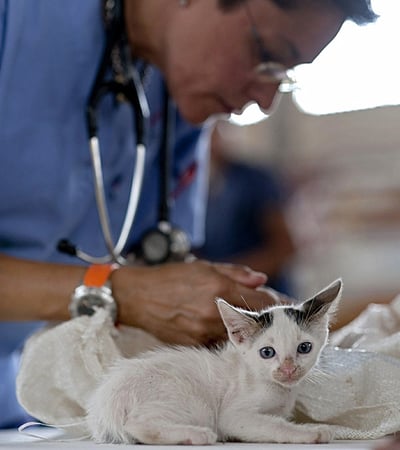 What cat vaccines are considered non-core or optional?
What cat vaccines are considered non-core or optional?
There are non-core or optional vaccines that are given based on your cat’s lifestyle and risk of exposure. They are:
Feline Bordetella
This disease is caused by a bacteria called Bordetella bronchiseptica. It is a highly contagious respiratory infection that causes inflammation of the trachea and bronchi.
The symptoms it causes are similar to those of viral upper respiratory infections.
This disease is most severe in kittens and appears to be uncommon in adult cats. There have been reports of fatal bronchopneumonia in kittens.
How Bordetella is transmitted or spread:
- By direct contact (licking or nuzzling)
- By indirect contact (sneezing or coughing)
- Transmission can occur between cats and dogs
Feline Bordetella vaccine is recommended for:
- Young cats that live in large, multi-cat households where there is a high risk of exposure
- Young cats that are boarded frequently
- Other cats that may benefit from the vaccine are those living in shelters, rescues centers, or pet stores, as well as those that participate in cat shows
Feline Infectious Peritonitis (FIP)
FIP is a mutated form of the feline coronavirus and is always fatal. Typically, the feline coronavirus causes no significant disease when it affects the gastrointestinal tract.
However, about 10 % of cats will have one or more mutations of the feline enteric coronavirus which results in FIP. FIP spreads throughout the body because it infects white blood cells.
The reaction to FIP in the body is an intense inflammatory reaction. This typically occurs around blood vessels in the tissues where the infected cells are located. The usual locations are the brain, abdomen, and kidneys.
This feline coronavirus is not related to COVID-19.
How FIP is transmitted or spread:
Unfortunately, the mode of transmission and infection is not completely understood.
The feline enteric coronavirus is shed in feces. Cats become infected with the gastrointestinal form. Typically the result is a flu-like reaction. But for some cats, this virus mutates and causes FIP.
Immunocompromised cats, such as seniors or those with FIV or FeLV are more susceptible to the feline coronavirus mutating into FIP.
Feline Immunodeficiency Virus (FIV)
This is a virus found only in cats. It works by weakening your cat’s immune system and making them susceptible to other diseases.
How FIV is transmitted or spread:
The disease is shed in saliva. It is typically transmitted from cat to cat by bite wounds. Contact with shared water and food bowls and litter boxes does not seem to cause infection.
The vaccine has been found to only protect against some but not all strains of FIV. The vaccine used has been found to interfere with the results of some tests. Some cats have been found to test positive for the disease up to 7 years after the last vaccination.
Typical in-clinic tests cannot differentiate between vaccine FIV- positive cats and true FIV- positive cats. This means more sophisticated and expensive testing is needed, and even those are not perfect at differentiating between the two. The vaccine is not available in the USA, Canada, and other countries.
Chlamydophilia (also referred to as Chlamydial Conjunctivitis)
This is an infection caused by bacteria.
Typical clinical signs include either watery or yellow discharge from one or both eyes, red and swollen conjunctiva, mild sneezing, and discharge from the nose.
How Chlamydophilia is transmitted or spread:
- It cannot survive outside the host and therefore requires close cat-to-cat contact
- During birth, kittens can become infected by their mother
Chlamydophilia vaccine is recommended for:
- Typically, it is used only in multi-cat households where there is confirmed infection and a control program is in place
- Additionally, it is sometimes recommended for cats that board often or are exposed to multiple cats (i.e., shelter or rescue)
Data shows1 that the vaccine provides insufficient protection and its use has been shown to cause a high rate of reactions.
What are the typical side effects of cat vaccinations?
Per the American Animal Hospital Association (AAHA), the reported rate of reactions within 30 days of the vaccination is 0.52%.
Normally, most reactions to a vaccine occur within hours of the vaccination.
Mild reactions to feline vaccines
- Swelling at the site of the injection
- Discomfort and mild pain at the vaccination site (so avoid touching that area on your cat)
- Mild fever for not more than 48 hours
- Lethargy for no more than 48 hours
- Lack of appetite for 24 to 48 hours
It is not uncommon for a small, firm swelling to develop at the site of the vaccination. These will typically disappear within a few weeks. Contact your veterinarian if they continue to grow in size or if they persist beyond 3 to 4 weeks.
More serious reactions to feline vaccines
These can occur, but they are significantly less common. These reactions include:
- Continual vomiting and diarrhea
- Hives
- Facial swelling
- Difficulty breathing
- Collapse
NOTE: If you notice any of these serious symptoms, contact a veterinarian immediately. Do not wait to speak with your veterinarian, if their office is closed, contact or go to an emergency hospital because these reactions can be life-threatening.
Feline injection-site sarcomas (FISS)
These rare cancerous tumors occur following an injection. They are aggressive tumors that invade local tissue and metastasize to other parts of the body. The specific cause has not been determined, but the theory is that they are due to an inflammatory process that results from the injection.
When cats are not able to control the inflammation, then a sarcoma will develop. Since vaccines are the most common injection cats receive, many pet owners worry about them. For the majority of cats, vaccination is low risk.
The rate of occurrence is approximately 1 incidence per 10,000 to 30,000 vaccinations.
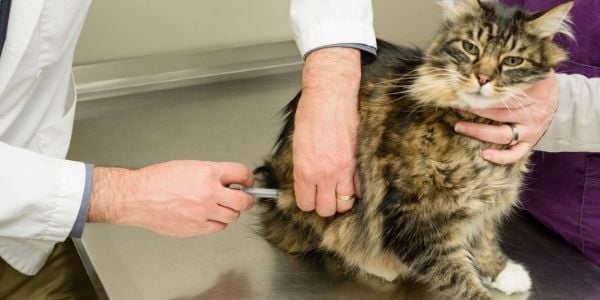
FISS is most commonly associated with the rabies and FeLV vaccines. These vaccines are recommended to be given as low as possible on the hind leg (right leg for rabies and left leg for FeLV) or at the lower portion of the tail. Speak to your veterinarian regarding your concerns about FISS.
Why Are Vaccines Important for Cats?
There are vaccines that will be recommended for different reasons by your veterinarian for your feline companion. Some vaccines are required by state law.
- Immunity without exposure to the disease. Vaccination is a safe and effective way for your cat to be exposed to a disease. This way, your cat develops their own immunity to the disease without actually getting sick from it.
- Vaccines can save your cat’s life. Some diseases can be fatal if not prevented.
- Disease can pass from cats to humans. Vaccines help to protect people, especially from rabies.
- Protection for other cats. Many of the viruses that vaccines prevent are shed in saliva, nasal and eye discharge, etc., and therefore the viruses are easily spread from cat to cat.
- Save time and money. The treatment and medical care for these diseases can be expensive and can be avoided.
- Save pain and suffering. In addition to saving time and money, vaccination spares your cat from suffering, as well as additional medical repercussions such as hospitalizations involving intravenous fluids and repeated injections.
How Your Veterinarian Determines Which Vaccines Your Cat Needs
When you bring your cat in for their wellness exam, your veterinarian will ask some of the following questions. Your answers and these factors are taken into account when vaccine protocols are determined for your cat. There are also many more factors, including local laws and regulations.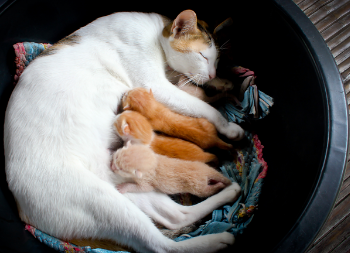
Your cat’s history
-
- Where did your cat come from? Shelter, breeder, pet store, rescue, stray, etc.
- What prior vaccines has your cat had?
- Was the mother of your cat vaccinated?
- What illnesses has your cat had?
Your cat’s age
Kittens often have different vaccine protocols than adult cats.Your cat’s lifestyle and environment
-
- Will your cat be strictly indoor?
- Will your cat be outdoor only?
- Will your cat be indoor but exposed to cats living outdoors?
- Will your cat travel with you?
- Will your cat be boarded?
- Does your cat go to events/competitions?
Your cat’s health
Do they currently have illnesses, such as FIV or FeLV?
What happens if you don't know the answers to these cat health and history questions? Don't be concerned. Vaccines are safe and your veterinarian will start a protocol based on your cat's age and the level of care they need. If a cat has been chronically sick the vet may delay start of vaccination.
Core Vaccine Schedule for Cats
Feline Viral Rhinotracheitis, Calicivirus, and Panleukopenia
This is a combination vaccine for the three viruses, and it is often referred to as a ‘distemper shot’ for cats.
Kitten Schedule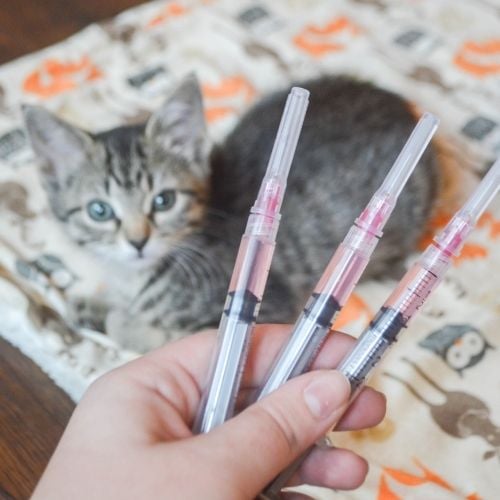
The vaccine is first given between 6 and 8 weeks of age. It is then boostered every 3 to 4 weeks until 16 to 18 weeks of age.
This vaccine used to be repeated 1 year later. However, due to the current recommendation of WSAVA, it is recommended to repeat this vaccine at 6 months of age.
This is due to the fact that one third of kittens have mother-derived antibodies (this provides immunity against disease for a kitten) up until 20 weeks of age.
Therefore, the immunity from the vaccine is blocked by the presence of the mother's immunity if not given after that point. The vaccine is then administered every 3 years after that.
Adult Cat Schedule
For cats receiving this "distemper" vaccine combination, as non-kittens, a series of two vaccines is given and then boostered a year later. They will then receive a booster every 3 years.
Feline Leukemia Virus (FeLV)
This vaccine is usually given as a series of two vaccines followed by another a year later. It is then given every one to three years thereafter, depending on your cat’s particular lifestyle.
Cats that are at high risk of exposure (see the reasons in the adult schedule below) should be vaccinated yearly (this is also dependent on the licensing of the vaccine your veterinarian uses).
Kitten Schedule
For kittens, FeLV is considered a core vaccine and is started between 9 and 12 weeks of age.
Adult Cat Schedule
Cats over a year of age FeLV is viewed as an optional or non-core vaccine. Any cat that is outdoor, indoor/outdoor, or is at risk of being exposed to an outdoor cat, should be vaccinated every year.
Testing is recommended prior to the administration of this vaccine to determine if your cat is already positive for the disease.
Rabies
The rabies vaccine is given as a single injection. Depending on each state's laws, the rabies vaccine is boostered yearly to every 3 years. If your cat has been vaccinated and exposed to a potentially rabid animal, the vaccine should be boostered immediately following exposure.
Any time unvaccinated cats have been exposed to a potentially rabid animal, local animal control authorities MUST be contacted.
Kitten Schedule
Given the first time between 12 and 14 weeks of age. It is then boostered a year later.
Adult Cat Schedule
Any cat over the age of 12 weeks with unknown vaccine history should automatically be vaccinated for rabies. It is then boostered a year later.
What Should You Do If You Miss Your Cat's Scheduled Vaccines?
It is always recommended to follow the vaccine booster schedule to provide the best possible protection for your cat.
If your kitten is 2 or more weeks late for their booster vaccine, their immune system may not be active any longer. When this happens, they mount less of an immune response to the following vaccine. Your veterinarian will need to decide, based on how delayed the booster was, what steps will be needed to best protect your cat.
Often, if the booster is delayed more than 3 to 4 weeks, a series of two vaccines will be given about 3 weeks apart in order to fully boost your cat’s immune system.
For adult cats – that are just starting a series of vaccines – they would need to have the series started over if there is a lapse of 6 weeks between vaccinations.
For annual booster vaccinations, if the vaccine is delayed more than 2 years past the recommended booster schedule, they will need to receive a series of 2 vaccines about 3 weeks apart.
Be sure to speak to your veterinarian as to the vaccine manufacturer's recommendations with regards to vaccine boosters.
NOTE: This does not apply to Rabies. This is a single-shot vaccination. By not keeping this vaccination current, it can result in quarantine of your cat if they are exposed to a potentially rabid animal.
Titer Testing for Cats
A titer is a test that is done using a sample of your cat’s blood to measure the level of antibodies to a specific disease. Antibodies are proteins made by the body as a response to antigens. Antigens are foreign substances or stimuli to the body, such as viruses, bacteria, or vaccinations, that cause the body to mount an immune response.
Vaccine titers are used as a screening tool to determine whether or not to revaccinate for a particular disease. If a vaccine titer comes back high, this indicates that your cat, if exposed to that disease, should be able to fight it off.
The problem with titers
Typically, vaccines are given every year. With titers, there is no way to predict what the levels will be in three to six months, even if they tested high at the time of the titer testing.
Many factors can affect the immune system and its level of resistance. Factors such as disease, stress, or medications can impact it, and therefore there is no consistency over time regarding what the antibody levels could be. This could put your cat at risk until you go in for another titer test.
How much do titers cost?
Oftentimes, titers can be more expensive than the vaccine. For example, a feline core vaccine titer can cost $70 to $100, whereas the vaccine costs $30 to $60.
There is always the chance that the titer will indicate that your cat will still need to be vaccinated, and there will be the possible added expense of an office visit in addition to the cost of the vaccine. Plus, there is the additional time involved to bring your cat back.
It is important to discuss with your veterinarian if they recommend your cat be re-vaccinated or have a titer done.
Each cat has unique needs, lifestyles, and risk factors. Your veterinarian is your best resource to help you make the right vaccine decisions for your cat.



